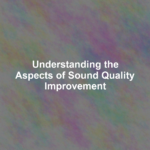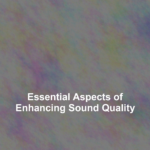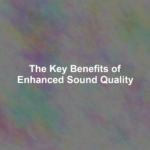Improving sound quality is like fine-tuning a high-performance engineG??it requires attention to detail, precision, and a deep understanding of the components at play. As you embark on this auditory journey, youG??ll discover that the path to crystal-clear sound involves more than just investing in high-end equipment.
ItG??s essential to consider the acoustic treatment of your environment, which can profoundly affect the listening experience. You must also navigate the complex world of audio file formats to ensure your media is in the best shape for playback.
And letG??s not forget the pivotal roles that mixing and mastering play in polishing a raw audio track into a masterpiece. But remember, even the best gear can falter without proper maintenance. Stick around, and youG??ll uncover how each of these aspects interlinks to elevate your sound from good to exceptional.
Acoustic Treatment Essentials
To significantly enhance your listening experience, itG??s crucial to understand and implement the basics of acoustic treatment in your space. Acoustic treatment is all about controlling sound reflections to improve the audio quality within a room. YouG??ll want to start with absorption panels, which reduce echoes and reverberation. Place these panels at reflection points where sound waves bounce off walls, typically opposite your speakers.
Next, consider bass traps. These are essential for controlling low-frequency sounds and are placed in room corners where bass tends to build up. Without bass traps, youG??re likely to experience a boomy or muddy sound.
Diffusers are another key element. They scatter sound waves, creating a more even distribution throughout the room. This means youG??ll get a natural, live sound quality, rather than the flatness that comes with over-absorption.
DonG??t forget about room dimensions and speaker placement. Your roomG??s shape and the position of your speakers dramatically affect sound quality. Try to place your speakers away from walls and in a configuration that creates an equilateral triangle with your listening position.
Audio File Formats Explained
While optimizing your roomG??s acoustics is essential for sound quality, choosing the right audio file format is just as crucial for preserving the integrity of your music. Different formats can greatly affect your listening experience, so itG??s important to understand your options.
LetG??s break down the most common types. Lossless formats like FLAC and ALAC maintain audio fidelity without any quality loss from the original recording. TheyG??re perfect if youG??re after the best sound and have enough storage space. However, these files are large, and not all devices support them.
On the other hand, lossy formats like MP3 and AAC compress audio data to create smaller files. YouG??ll sacrifice some quality, but these are widely compatible and convenient for streaming or when youG??re limited on storage.
Then thereG??s uncompressed audio, such as WAV and AIFF. These files are true to the original recording but take up significant space. TheyG??re ideal for editing and professional use but might be overkill for casual listening.
High-Quality Playback Equipment
Investing in high-quality playback equipment can drastically enhance your audio experience, ensuring that every note and nuance is heard with crystal clarity. ItG??s not just about cranking up the volume; itG??s about the purity of sound, the depth of bass, and the precision of trebles that high-end equipment can provide.
YouG??ll notice the difference when you listen through a set of premium headphones or speakers. TheyG??re designed with superior materials and technology that can reproduce sound as it was intended to be heard. DonG??t underestimate the power of a good DAC (Digital-to-Analog Converter) or amplifier either. TheyG??re pivotal in minimizing distortion and maintaining the integrity of the audio signal from source to speaker.
But remember, itG??s not only about splurging on the most expensive gear. ItG??s about finding the right setup that fits your listening preferences and the acoustics of your space. Seek out equipment that supports the audio formats you frequently use and matches the input quality.
Lastly, ensure your playback devices are properly calibrated. Even the best equipment can fall short if itG??s not tuned correctly. So, take the time to adjust settings and placement for optimal sound quality. Trust me, your ears will thank you.
The Role of Mixing and Mastering
Mixing and mastering are crucial steps in the production process that transform a raw recording into a polished, professional-sounding track. When youG??re listening to your favorite song, itG??s easy to overlook the meticulous effort that went into making it sound just right. But without a skilled touch in these final stages, even the most beautifully written piece could fall flat to your ears.
HereG??s what you get when mixing and mastering are done right:
- Clarity: Each instrument finds its place, ensuring youG??re not straining to hear the strum of a guitar or the whisper of the background vocals.
- Balance: The bass wonG??t overwhelm you, nor will the treble make you wince; everything sits in harmony.
- Emotional Impact: The intended feelings and dynamics of the song are enhanced, pulling you into the story or the groove.
- Volume Levels: Your track competes on the same playing field as major hits, without you having to constantly adjust the volume.
As you dive into your next sonic adventure, remember that itG??s the invisible art of mixing and mastering that shapes the soundscape, creating an immersive experience that can bring joy, comfort, or even chills. ItG??s these nuances that turn mere noise into a masterpiece for your ears.
Maintaining Equipment for Optimal Performance
To ensure your audio gear consistently delivers top-notch sound, regular maintenance is essential. Dust and dirt can be your equipmentG??s worst enemies, leading to static, interference, or even damage. Start with simple habits like dusting your components with a soft brush or microfiber cloth. DonG??t forget to periodically unplug and clean connectors with a contact cleaner to prevent oxidation and ensure solid connections.
Your listening environment matters, too. Keep your equipment away from extreme temperatures and humidity. These conditions can warp materials and corrode electronics, shortening the lifespan of your gear. If youG??re using turntables, recalibrate the tonearm and replace the stylus as recommended to avoid distortion and record wear.
Conclusion
YouG??ve got the basics down: treat your space, choose the right file formats, invest in top-notch gear, and donG??t underestimate mixing and mastering.
Remember, keeping your equipment in tip-top shape is crucial.
Follow these steps, and youG??ll elevate your sound quality to new heights.
Dive in, tweak, and fine-tune. Your earsG??and your audienceG??will thank you for the sonic bliss youG??ll deliver.
Now, go make some noise thatG??s music to the worldG??s ears!











